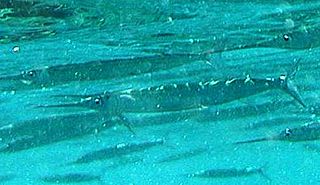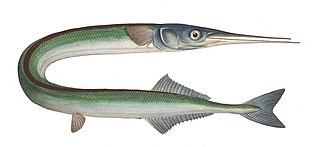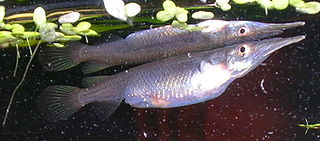
Gars are members of the family Lepisosteidae, which are the only surviving members of the Ginglymodi, an ancient holosteian group of ray-finned fish, which first appeared during the Triassic, over 240 million years ago. Gars comprise seven living species of fish in two genera that inhabit fresh, brackish, and occasionally marine waters of eastern North America, Central America and Cuba in the Caribbean, though extinct members of the family were more widespread. Gars have elongated bodies that are heavily armored with ganoid scales, and fronted by similarly elongated jaws filled with long, sharp teeth. Gars are sometimes referred to as "garpike", but are not closely related to pike, which are in the fish family Esocidae. All of the gars are relatively large fish, but the alligator gar is the largest; the alligator gar often grows to a length over 2 m (6.5 ft) and a weight over 45 kg (100 lb), and specimens of up to 3 m (9.8 ft) in length have been reported. Unusually, their vascularised swim bladders can function as lungs, and most gars surface periodically to take a gulp of air. Gar flesh is edible and the hard skin and scales of gars are used by humans, but gar eggs are highly toxic.
Hemiramphidae is a family of fishes that are commonly called halfbeaks, spipe fish or spipefish. They are a geographically widespread and numerically abundant family of epipelagic fish inhabiting warm waters around the world. The halfbeaks are named for their distinctive jaws, in which the lower jaws are significantly longer than the upper jaws. The similar viviparous halfbeaks have often been included in this family.

Needlefish or long toms are piscivorous fishes primarily associated with very shallow marine habitats or the surface of the open sea. Some genera include species found in marine, brackish, and freshwater environments, while a few genera are confined to freshwater rivers and streams, including Belonion, Potamorrhaphis, and Xenentodon. Needlefish closely resemble North American freshwater gars in being elongated and having long, narrow jaws filled with sharp teeth, and some species of needlefishes are referred to as gars or garfish despite being only distantly related to the true gars. In fact, the name "garfish" was originally used for the needlefish Belone belone in Europe and only later applied to the North American fishes by European settlers during the 18th century.

Hemiramphus is a genus of schooling marine fish commonly called halfbeaks, garfish, or ballyhoos, and are members of the family Hemiramphidae. They inhabit the surface of warm temperate and tropical sea, and feed on algae, plankton, and smaller fish. Hemiramphus species are edible but are more important as food fish for larger predatory species including dolphinfish and billfish.

The garfish, also known as the garpike or sea needle, is a pelagic, oceanodromous needlefish found in brackish and marine waters of the Atlantic Ocean and the Mediterranean, Caribbean, Black, and Baltic Seas.
Australia has over 5000 described species of fish, a quarter of which are endemic. Seafood and aquaculture are major and highly regulated industries, and fishing for marine and freshwater native fish is popular.

Hyporhamphus ihi, the garfish or piper, is a halfbeak found all around New Zealand in shallow inshore waters.

Arrhamphus sclerolepis, the Northern snub-nosed garfish, is a species of halfbeak in the genus Arrhamphus found in coastal waters of the Indo-West Pacific around Papua New Guinea and Australia, and in the freshwaters of adjacent river systems. Considered a good game fish, but of little commercial value either as food or as an aquarium fish. This species is known to anglers in Australia as the snub-nosed gar. The species is distinguished from most other halfbeaks by the lower jaw being only slightly longer than the upper jaw.

The long-winged harrier is a common bird of prey species endemic to South America. They are members of the family Accipitridae, under the genus Circus which encompasses other harrier species. Its range encompasses most of South America, in grassland and wetland all across the continent. The long-winged harrier is a carnivorous bird, and will feed on many different animals found in its habitat.
Allen's river garfish is a species of viviparous halfbeak endemic to West Papua in Indonesia.

Zenarchopterus is a genus of viviparous halfbeaks. These fish are found in marine, brackish and fresh water of the Indo-Pacific region. Despite being in the viviparous halfbeak family, Zenarchopterus species are oviparous.
Robert's river garfish is a species of viviparous halfbeak endemic to Papua New Guinea where it is only known from the area around Kokoda. This species grows to a length of 13 centimetres (5.1 in) SL.

Fishing within the Bailiwick of Guernsey is common place. The bailiwick is made up of several islands in the Channel Islands, namely.

The Wenlock River is a river located on the Cape York Peninsula in Far North Queensland, Australia.
The Calvert River is a river in the Northern Territory of Australia.

Hyporhamphus is a genus of halfbeaks. The species in this genus are distributed throughout the warmer seas of the world, most species being Indo-Pacific and there are some freshwater species.
The short-beaked garfish is an uncommon species of needlefish in marine waters of the eastern Atlantic Ocean. This pelagic needlefish is present off the coasts of Ireland, Spain, Portugal, and the United Kingdom, and possibly in the Mediterranean Sea, as well. This species was thought to be the same as the garfish because they share the same waters. The short-beaked garfish matures at 30 cm (12 in) and can grow to a maximum of 65 cm (26 in) while Belone belone can be 95 cm (38 in). Like all needlefish, this one has an elongated body with beak-like jaws that are lined with razor sharp teeth. The short-beaked garfish's lower jaw is longer than the upper. Its body is silvery like most needlefish and has a black stripe running across its lateral line. The dorsal and anal fins are very close to the caudal peduncle. These fish are oviparous. Eggs may be found attached to objects in the water by tendrils on the egg's surface. These spherical eggs are dispersed on the sea floor (demersal). Not much is known about this fish's feeding habits. It likely preys on small oceangoing fish. It has been caught using mackerel. Needlefish tend to be surface fish, so are preyed upon like Atlantic mackerel, European pilchard, sand smelt, etc. The specific name honours Anatolii Nikolaevich Svetovidov (1903-1985) who was an ichthyologist at the Zoological Institute in Saint Petersburg, Russia and a colleague of N.V. Parin.
The black-tipped halfbeak, Hyporhamphus neglectissimus, is a halfbeak from the family Hemiramphidae.

Zenarchopteridae, the viviparous halfbeaks, is a family in the order Beloniformes. The Zenarchopteridae exhibit strong sexual dimorphism, practicing internal fertilisation, and in some cases ovoviviparous or viviparous. The members in the family are mainly found in fresh and brackish water of tropical Asia and New Guinea, but the genus Zenarchopterus also includes marine species from the Indo-Pacific. Several, such as the wrestling halfbeak, have become commonly traded aquarium fish.
The feathered river garfish, also known as the estuarine halfbeak, spoon-fin garfish, spoon-fin river garfish and viviparous half beak, is a species of marine, freshwater, brackish and reef-associated oceanodromous viviparous halfbeak found in Indo-Pacific regional countries, such as Kenya, Mozambique, Seychelles, Madagascar, New Guinea, Solomon Islands, Australia, New Caledonia, Fiji, Sri Lanka, India, Vanuatu, Malaysia, Thailand, Singapore and Samoa.












